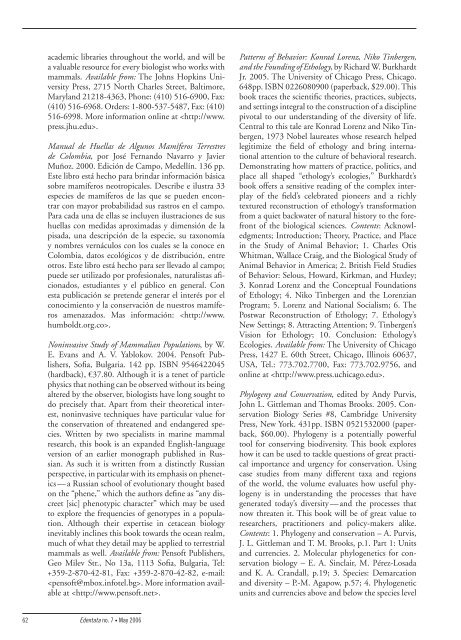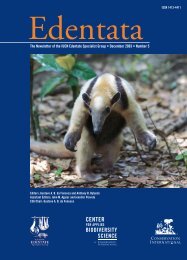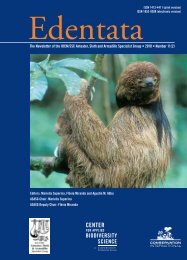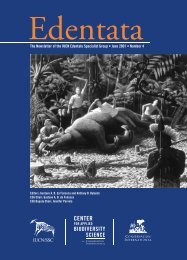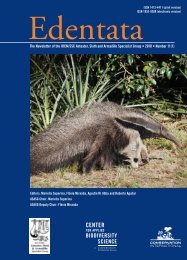Edentata 7 - Anteater, Sloth & Armadillo Specialist Group
Edentata 7 - Anteater, Sloth & Armadillo Specialist Group
Edentata 7 - Anteater, Sloth & Armadillo Specialist Group
- No tags were found...
Create successful ePaper yourself
Turn your PDF publications into a flip-book with our unique Google optimized e-Paper software.
academic libraries throughout the world, and will be<br />
a valuable resource for every biologist who works with<br />
mammals. Available from: The Johns Hopkins University<br />
Press, 2715 North Charles Street, Baltimore,<br />
Maryland 21218-4363, Phone: (410) 516-6900, Fax:<br />
(410) 516-6968. Orders: 1-800-537-5487, Fax: (410)<br />
516-6998. More information online at .<br />
Manual de Huellas de Algunos Mamíferos Terrestres<br />
de Colombia, por José Fernando Navarro y Javier<br />
Muñoz. 2000. Edición de Campo, Medellín. 136 pp.<br />
Este libro está hecho para brindar información básica<br />
sobre mamíferos neotropicales. Describe e ilustra 33<br />
especies de mamíferos de las que se pueden encontrar<br />
con mayor probabilidad sus rastros en el campo.<br />
Para cada una de ellas se incluyen ilustraciones de sus<br />
huellas con medidas aproximadas y dimensión de la<br />
pisada, una descripción de la especie, su taxonomía<br />
y nombres vernáculos con los cuales se la conoce en<br />
Colombia, datos ecológicos y de distribución, entre<br />
otros. Este libro está hecho para ser llevado al campo;<br />
puede ser utilizado por profesionales, naturalistas aficionados,<br />
estudiantes y el público en general. Con<br />
esta publicación se pretende generar el interés por el<br />
conocimiento y la conservación de nuestros mamíferos<br />
amenazados. Mas información: .<br />
Noninvasive Study of Mammalian Populations, by W.<br />
E. Evans and A. V. Yablokov. 2004. Pensoft Publishers,<br />
Sofia, Bulgaria. 142 pp. ISBN 9546422045<br />
(hardback), €37.80. Although it is a tenet of particle<br />
physics that nothing can be observed without its being<br />
altered by the observer, biologists have long sought to<br />
do precisely that. Apart from their theoretical interest,<br />
noninvasive techniques have particular value for<br />
the conservation of threatened and endangered species.<br />
Written by two specialists in marine mammal<br />
research, this book is an expanded English-language<br />
version of an earlier monograph published in Russian.<br />
As such it is written from a distinctly Russian<br />
perspective, in particular with its emphasis on phenetics<br />
— a Russian school of evolutionary thought based<br />
on the “phene,” which the authors define as “any discreet<br />
[sic] phenotypic character” which may be used<br />
to explore the frequencies of genotypes in a population.<br />
Although their expertise in cetacean biology<br />
inevitably inclines this book towards the ocean realm,<br />
much of what they detail may be applied to terrestrial<br />
mammals as well. Available from: Pensoft Publishers,<br />
Geo Milev Str., No 13a, 1113 Sofia, Bulgaria, Tel:<br />
+359-2-870-42-81, Fax: +359-2-870-42-82, e-mail:<br />
. More information available<br />
at .<br />
Patterns of Behavior: Konrad Lorenz, Niko Tinbergen,<br />
and the Founding of Ethology, by Richard W. Burkhardt<br />
Jr. 2005. The University of Chicago Press, Chicago.<br />
648pp. ISBN 0226080900 (paperback, $29.00). This<br />
book traces the scientific theories, practices, subjects,<br />
and settings integral to the construction of a discipline<br />
pivotal to our understanding of the diversity of life.<br />
Central to this tale are Konrad Lorenz and Niko Tinbergen,<br />
1973 Nobel laureates whose research helped<br />
legitimize the field of ethology and bring international<br />
attention to the culture of behavioral research.<br />
Demonstrating how matters of practice, politics, and<br />
place all shaped “ethology’s ecologies,” Burkhardt’s<br />
book offers a sensitive reading of the complex interplay<br />
of the field’s celebrated pioneers and a richly<br />
textured reconstruction of ethology’s transformation<br />
from a quiet backwater of natural history to the forefront<br />
of the biological sciences. Contents: Acknowledgments;<br />
Introduction; Theory, Practice, and Place<br />
in the Study of Animal Behavior; 1. Charles Otis<br />
Whitman, Wallace Craig, and the Biological Study of<br />
Animal Behavior in America; 2. British Field Studies<br />
of Behavior: Selous, Howard, Kirkman, and Huxley;<br />
3. Konrad Lorenz and the Conceptual Foundations<br />
of Ethology; 4. Niko Tinbergen and the Lorenzian<br />
Program; 5. Lorenz and National Socialism; 6. The<br />
Postwar Reconstruction of Ethology; 7. Ethology’s<br />
New Settings; 8. Attracting Attention; 9. Tinbergen’s<br />
Vision for Ethology; 10. Conclusion: Ethology’s<br />
Ecologies. Available from: The University of Chicago<br />
Press, 1427 E. 60th Street, Chicago, Illinois 60637,<br />
USA, Tel.: 773.702.7700, Fax: 773.702.9756, and<br />
online at .<br />
Phylogeny and Conservation, edited by Andy Purvis,<br />
John L. Gittleman and Thomas Brooks. 2005. Conservation<br />
Biology Series #8, Cambridge University<br />
Press, New York. 431pp. ISBN 0521532000 (paperback,<br />
$60.00). Phylogeny is a potentially powerful<br />
tool for conserving biodiversity. This book explores<br />
how it can be used to tackle questions of great practical<br />
importance and urgency for conservation. Using<br />
case studies from many different taxa and regions<br />
of the world, the volume evaluates how useful phylogeny<br />
is in understanding the processes that have<br />
generated today’s diversity — and the processes that<br />
now threaten it. This book will be of great value to<br />
researchers, practitioners and policy-makers alike.<br />
Contents: 1. Phylogeny and conservation – A. Purvis,<br />
J. L. Gittleman and T. M. Brooks, p.1. Part 1: Units<br />
and currencies. 2. Molecular phylogenetics for conservation<br />
biology – E. A. Sinclair, M. Pérez-Losada<br />
and K. A. Crandall, p.19; 3. Species: Demarcation<br />
and diversity – P.-M. Agapow, p.57; 4. Phylogenetic<br />
units and currencies above and below the species level<br />
62<br />
<strong>Edentata</strong> no. 7 • May 2006


